Bioavailability and Nutrition

By Dr Duncan Houston, Veterinarian and Pet Nutritionist
Food is one of the ways we show love to our pets, but are they getting the nutrients their cells need to survive or to thrive?
Dry food, canned food, raw food, dog rolls, supplements, treats... There are a range of options available to feed our pets and these often differ when it comes to where the nutrition they contain comes from.
Most processed pet foods, especially if they want to claim that they are ‘complete and balanced’, gain their nutrition from a synthetic mix of vitamins and minerals whereas natural products rely on vitamins and minerals naturally present in the ingredients used to make the food.
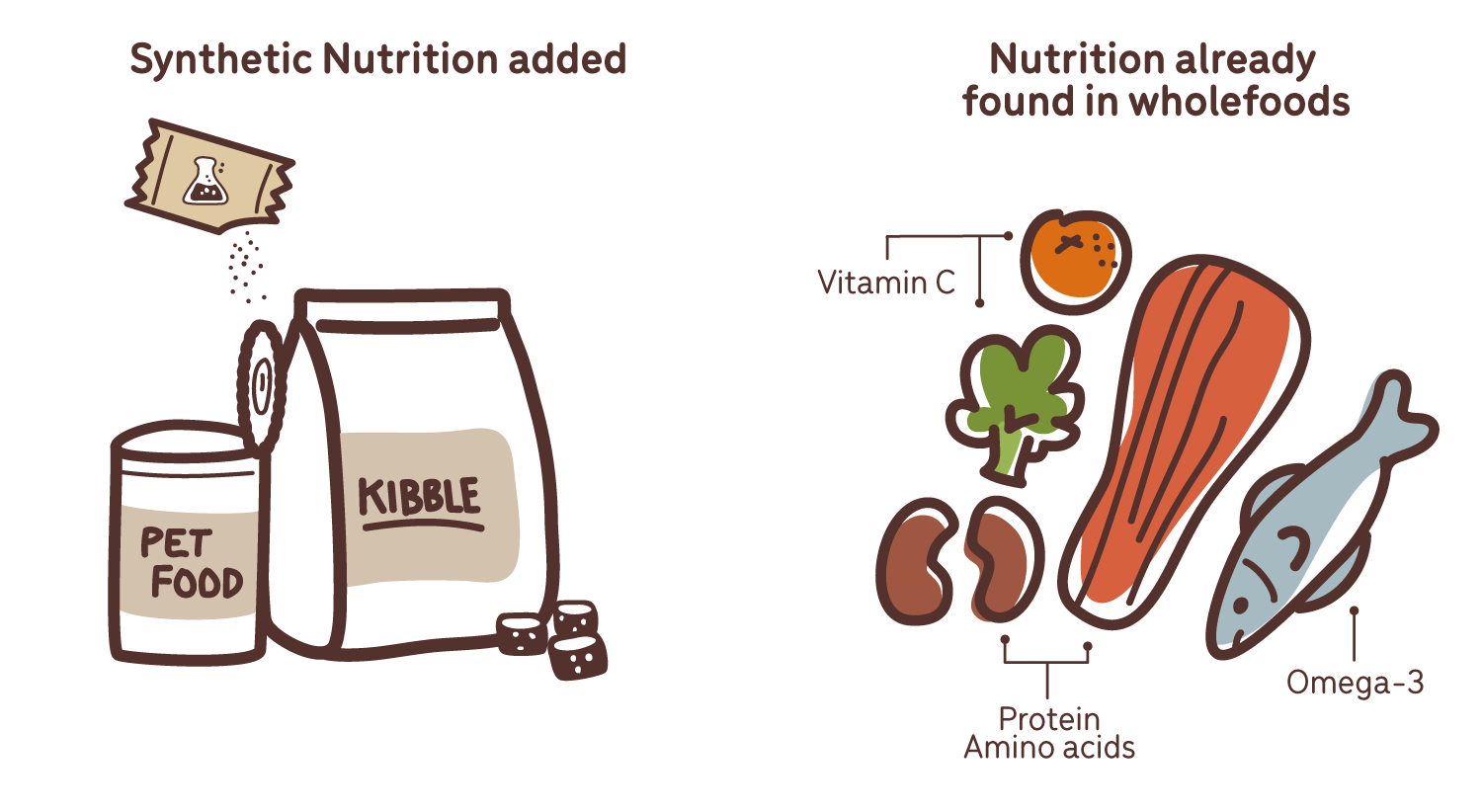
The Association of American Feed Control Officials (AAFCO) is one of the two international bodies that provides standards for pet foods and their guidelines give pet food companies criteria for their diets to meet. One of which is to provide a certain ‘minimum’ number of vitamins and minerals, at a certain level. What they don’t mandate or provide guidance on, is in what form these nutrients need to be present in and if form, impacts the required levels. What scares me is that certain pet food companies state they ‘exceed’ AAFCO and European Pet Food Industry Federation (FEDIAF) requirements. All this means is that they are above the minimum requirements, what it doesn’t tell me is if the vitamins and minerals within the foods are potentially at toxic levels.
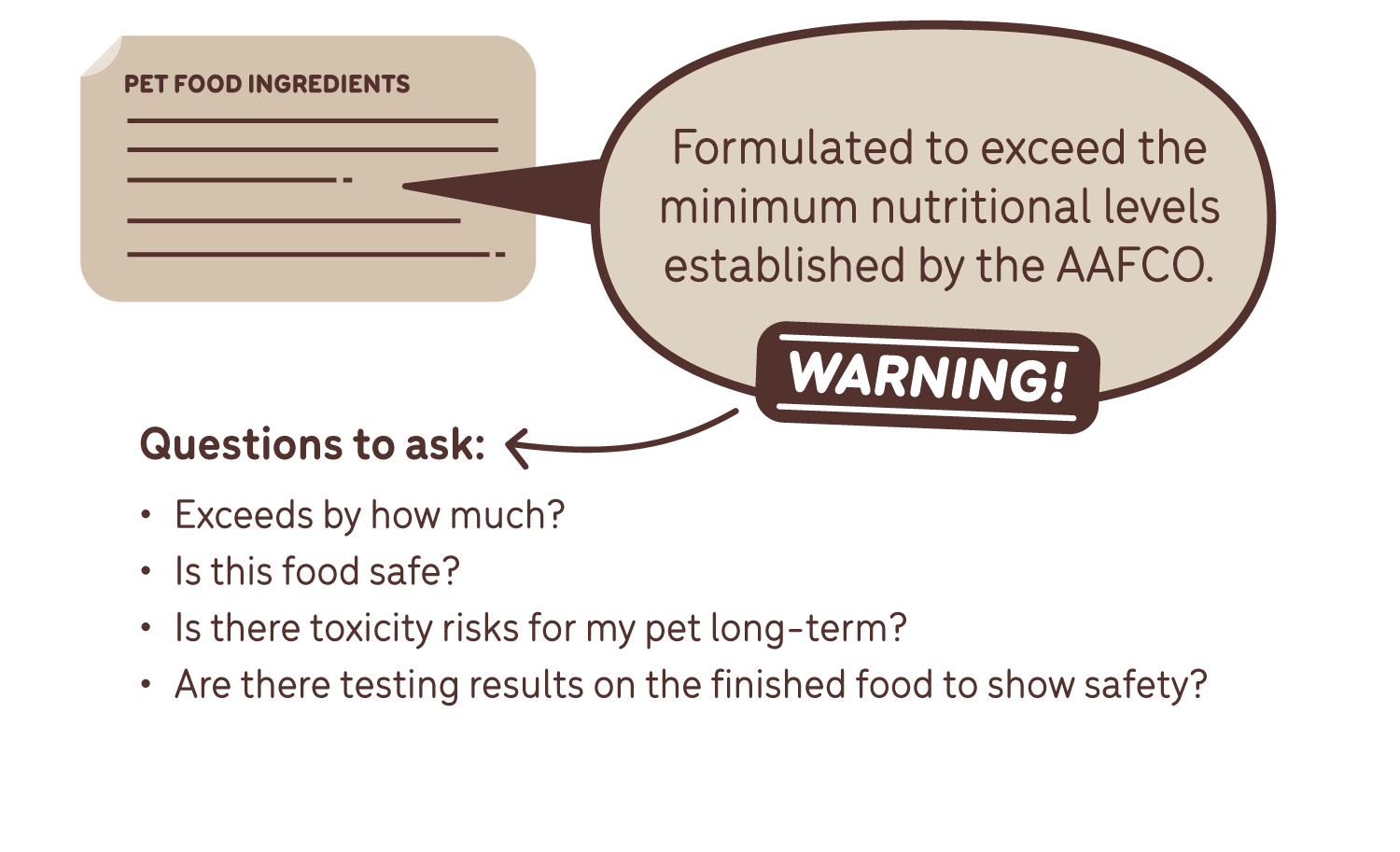
So I started thinking… Synthetic vs. Natural; which is better, why is one better than the other, can either be dangerous, can anything we do alter them, and how can we tell all this?
One way to measure this is through bioavailability, defined as the extent or rate at which a substance or drug enters an animal's body to become available to its intended biological destination or site(s) of action. Although it’s not always easy to test as bioavailability can vary widely between animals. For this article we’ll simply be comparing the bioavailability of nutrients from natural and synthetic sources of foods (8,16,17).
The whole is greater than the sum of its parts

This age old saying is no truer than looking at nutrition in its whole food form as nature intended. The research behind the bioavailability of nutrients from natural sources shows they are either equal to or more potent in comparison to synthetic supplements. This may be because they also contain a range of vitamins, minerals and other beneficial nutrients which can improve the bioavailability.
The concept of nutrition really only came about a bit over 100 years ago due to the increase in popularity of food processing. Bioavailability is even more recent nutrition-centred concept, and is an area that we are continually learning more about, as the science evolves (24).
What we currently understand about the bioavailability of nutrients is that there are multiple mechanisms which influence their absorption, utilisation and ultimately, their bioavailability.
Some being;
- Particle size, as it is an important factor in nutrient absorption (generally smaller is better),
- How nutrients within foods interact with each other can affect absorption,
- How synthetic nutrients are different in their physichemical form when compared to natural ones, and,
- How most synthetic vitamins are different in their structures/forms to their natural ones
Several studies have shown that nutrients derived from natural foods are less toxic, more absorbable and last longer within the body when compared to their synthetic isolate counterparts (28,29,30,31).
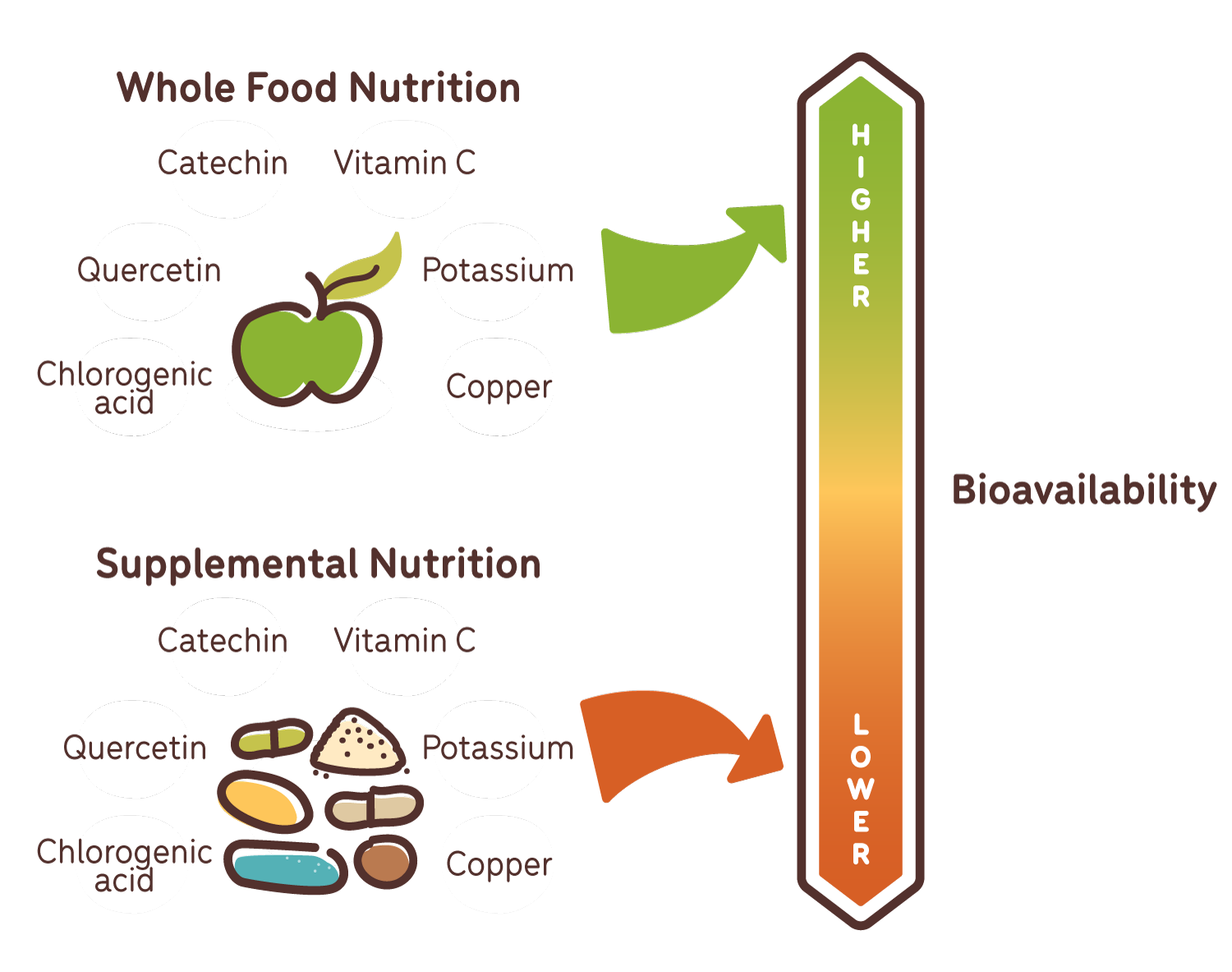
Let’s take a Vitaminute and look a little deeper
“Vitamins are organic substances that are essential in small amounts for the health, growth, reproduction, and maintenance of one or more animal species, which must be included in the diet since they cannot be synthesized at all or in sufficient quantity in the body. Each vitamin performs a specific function, hence one cannot replace another. Vitamins originate primarily in plant tissues.”(10) Most AAFCO or FEDIAF mixes added to pet foods are not organic and are generally chemically synthesised isolates. In nature vitamins are in the form of food-vitamin complexes and never isolates which affects their absorption, utilisation and bioavailability (10,24).
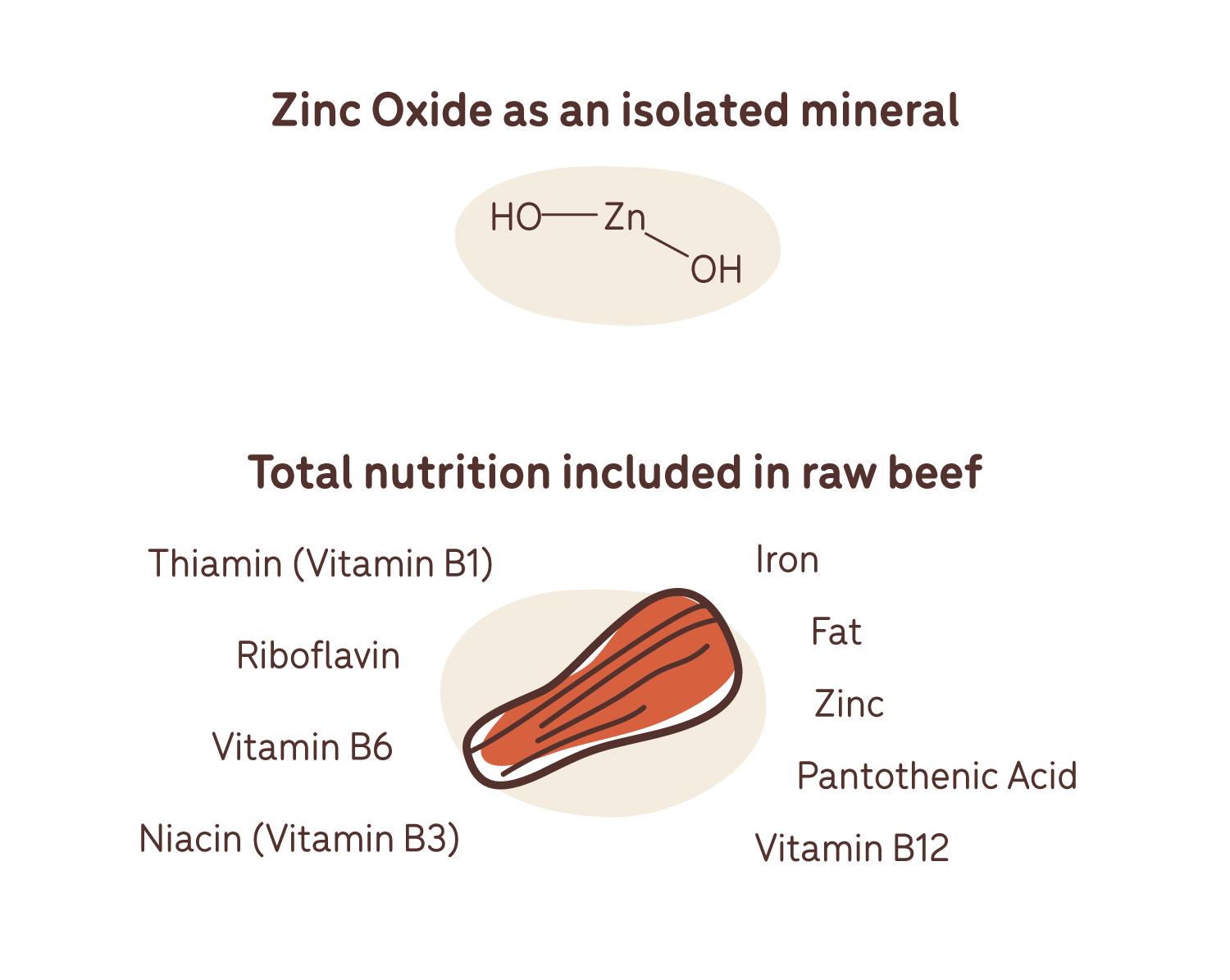
Vitamins are either water or fat soluble. Water soluble vitamins are very safe as our pet’s bodies pass the excess through their urine without the risk of toxicity. Water soluble vitamins are the B group vitamins and vitamin C.
Fat soluble vitamins on the other hand are not excreted in urine, they build up in our bodies over time. These vitamins are A, D, E and K. Fat soluble vitamins, as well as some notable minerals including iodine and zinc, should not be taken in excess as the amounts added have the potential to result in toxicity within the body as they accumulate in our pet’s bodies over time. These risks need to be considered for all foods that are fortified with an AAFCO or FEDIAF mix, which for some products in the past have been added in toxic amounts.
This is evident from a Hill’s recall in 2019, which involved vitamin D toxicity across multiple types of their foods. The issue here being that Hill’s did not manufacture this product themselves and their manufacturer did not test the finished products to make sure they met the required nutrient levels (both the lower and upper limits, where specified) and the toxicity went unnoticed until animals who ate the food started to become ill.
An example of the difference in bioavailability of vitamins can be seen with Vitamin C which is common in fruits and vegetables, but can also be chemically synthesised. Synthetic and food derived Vitamin C are both chemically identical, but have organically different structures. In a natural product like fruit there are also numerous nutrients (fibre, vitamins, minerals and other phytochemicals) which influence the bioavailability. Various animal studies have shown that natural is beneficial over synthetic despite several human studies finding them to be comparable. Humans and animals have different dietary needs and animal nutrition studies are generally more controlled than human ones; this could be a potential reason why the results differ.
Studies showed that diets high in natural vitamin C content from fruits and vegetables were associated with lower risks of certain cancers. Whereas diets high in vitamin C content from supplements had no effect on the development of cancer. It’s also been shown that vitamin C from natural sources is absorbed in higher amounts into the bloodstream and that vitamin C from citrus decomposes more slowly within the body than when obtained from synthetic sources (14,19,27,28,29,33).
Similarly studies showed that the absorption, utilisation and bioavailability of almost all vitamins when consumed in their natural states, from whole foods, were either in equal or much higher amounts. For example, natural vitamin E is absorbed over twice as effectively as synthetic even though they have identical molecular structures (22,28,29,30).
Synthetic isolates were primarily developed due to costs, but likely also for standardisation and stability. None of these reasons show to me that they were developed to be better for us or our pets than natural options. In fact some synthetic vitamins have been shown to have no action, some prevent natural vitamins from their jobs and others can produce deficiency symptoms.
Although I will say that synthetic vitamins aren’t always bad. In specific forms they may be helpful in certain circumstances as they can be dosed in more concentrated amounts frequently, even though they may not be as bioavailable and pose certain risks. If there is a natural supplement option then definitely use this over a synthetic one. I would only use these in certain circumstances where an animal may not be ingesting its adequate dietary intake due to lack of an appetite or for certain diseases. When supplementing this way you should monitor for any potential toxicity through regular blood tests to ensure the dose stays within the therapeutic range, and doesn’t exceed it. You just need to know that there is a risk, to be careful when and how they are used, and that if there is the option to use natural over synthetic then natural is always the better option for the body (21,22,24).
With all studies there are many variabilities but as more research is performed in this area, we will continue to learn more. The studies thus far, help to demonstrate that natural vitamins cannot be replaced by synthetics, even though synthetic nutrients do show potential benefits in certain situations. This is especially true when it comes to processed foods which are impacted so significantly by heat in their production that without synthetic nutrition being added, they would be void of any nutrition at all.
For now it appears to be more beneficial having the same dose of any specified amount of a nutrient through natural sources when compared to synthetic due to the advantages of additional micronutrients (vitamins and minerals), dietary fiber and phytochemicals. In fact natural diets have been shown to reduce/prevent some common fatal diseases in humans whereas the consumption of synthetics have not or need further studies to confirm (13,16,21,22,24).
Synthetics can keep trying but they ain’t got nothing on natural antioxidants!
Human studies have also shown that an increased consumption of fruits and vegetables can help to prevent chronic diseases such as cardiovascular disease and cancer. Specific fruits and vegetables such as citrus fruits, carotene-rich fruits and vegetables (recognisable through their orange colour), as well as cruciferous vegetables including broccoli and cauliflower, were highlighted as those which specifically reduced the risk of cancer. It is still not certain why this is exactly, whether it is due to the antioxidants, phytochemicals, or something else; but the benefit of including these in the diet has been clearly shown.
Despite not understanding all of the unique ways in which fresh foods assist our bodies, and those of our pets, we do know they play a role in combating oxidative stress. Oxidative stress, induced by free radicals, is involved in the development of many chronic diseases. Consuming a wide range of fruits and vegetables results in an intake of a variety of antioxidants and phytochemicals which help combat free radicals and oxidative stress (15,18,20).
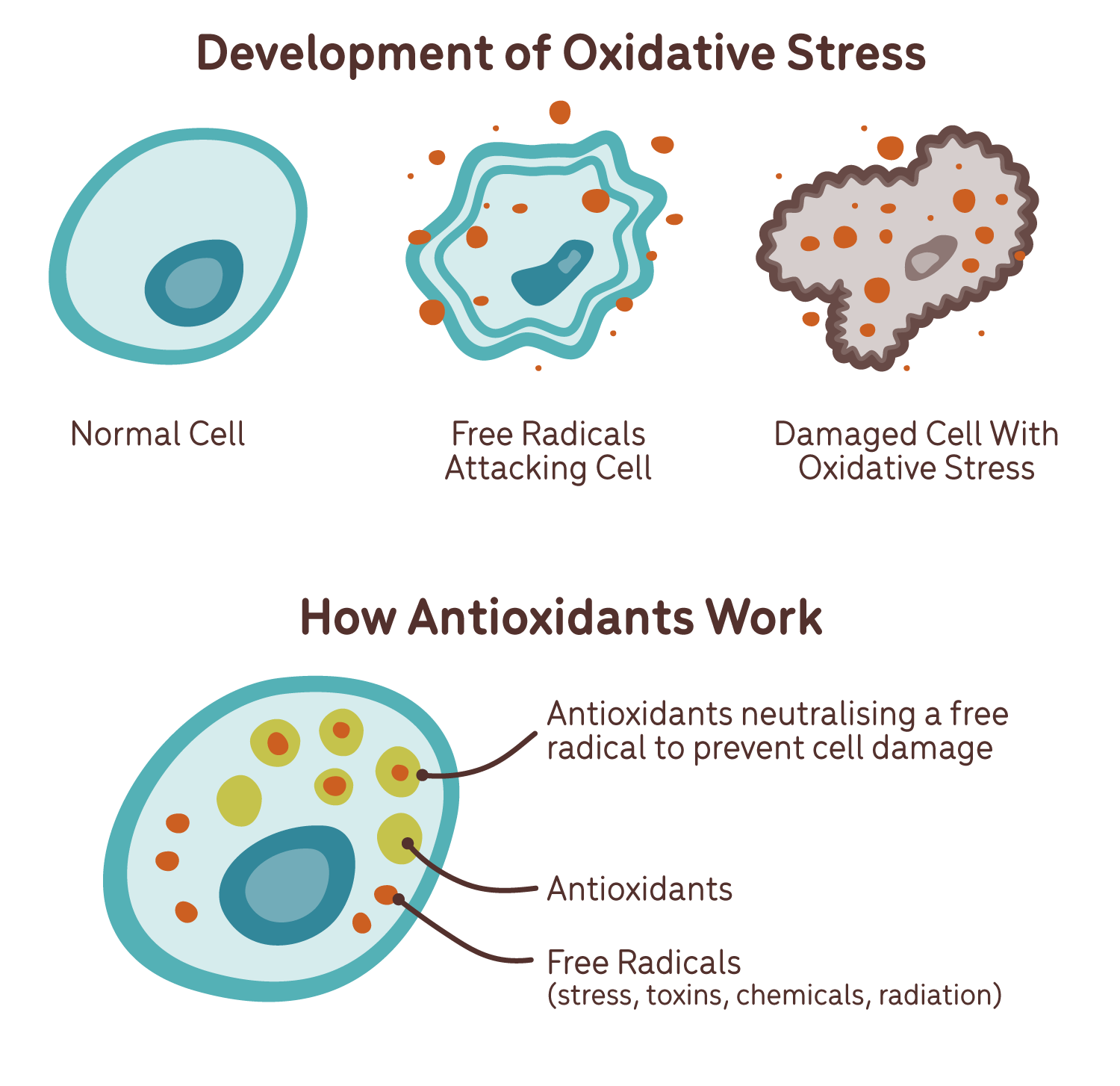
Antioxidant supplements have been shown to not have the same effect as those in fresh fruits and vegetables as they do not appear to have consistent preventative effects. These isolated pure compounds can lose their bioactivity as they only work in combination with others or they may not behave in the same way as they do when part of whole foods. The different compounds in these whole foods differ in molecular size, polarity and solubility which can affect the bioavailability and distribution of phytochemicals in different parts of the body. Hence, it’s best to derive a diet from a wide variety of whole foods rather than specific isolated nutritional supplements if you are aiming to reduce the incidence of chronic diseases (15,18,20).
Different types of foods can contain the same nutrients but in different forms. Meaning that the same nutrients can potentially be more or less bioavailable from different sources. The bioavailability of synthetic nutrients will be different depending on the compound the body is attempting to absorb them from. Cheaper products are generally not absorbed as well but are less expensive to source and produce (13,16).
Vitamin E is a great example here. In nature, vitamin E occurs in 8 different forms but it is difficult to synthesise in a laboratory, so supplemental vitamin E usually contains only the alpha form of vitamin E. The bioavailability of vitamin E in its natural form is twice that of its synthetic counterpart (6).
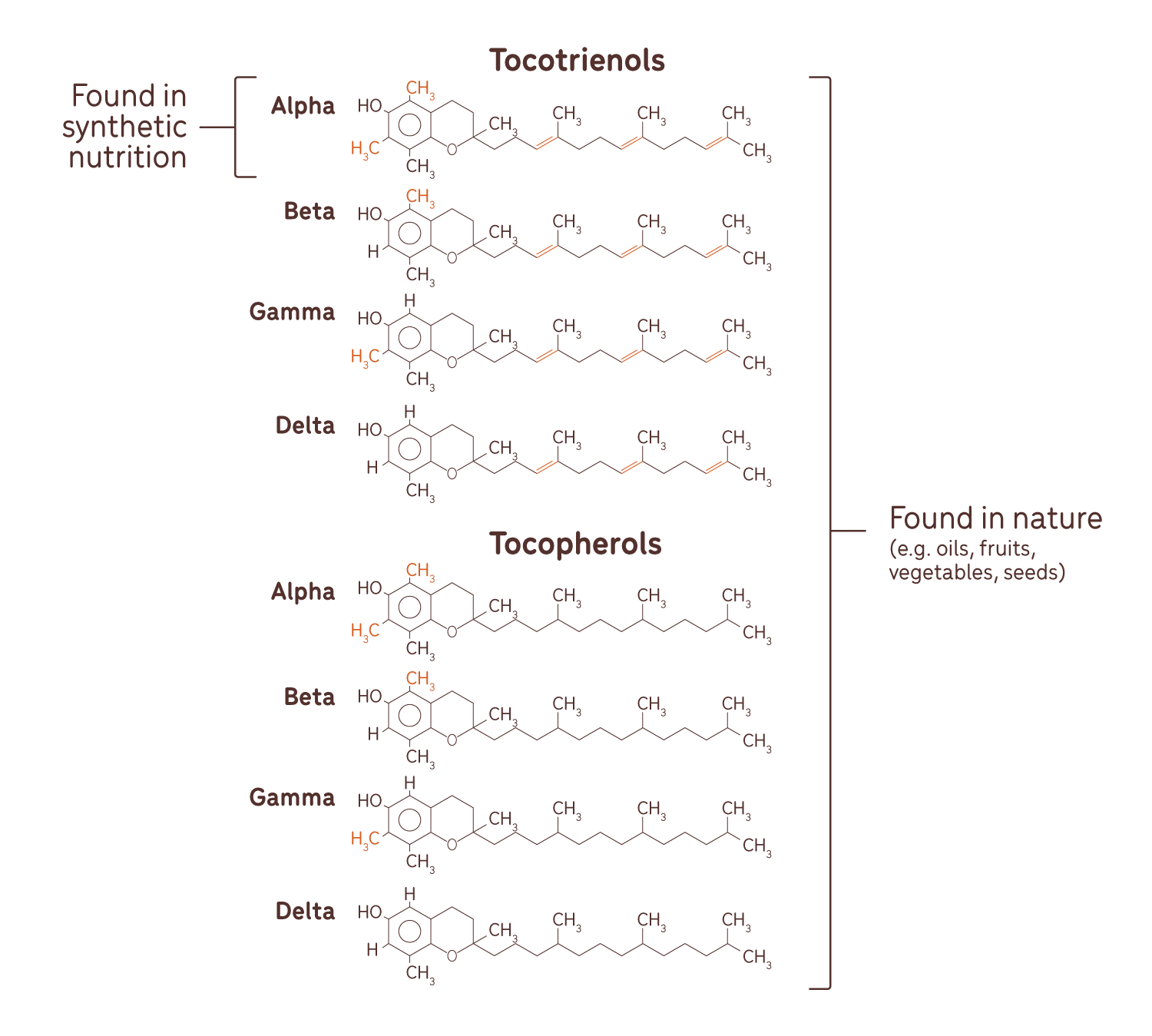
But how do we relate this information back to our pets' food?
Preservation methods and food processing techniques such as cooking, adding preservatives, freezing, etc. of foods and supplements (whether natural or synthetic) have been shown to affect the nutrients within them, whether to destroy them or affect their bioavailability.
The bioavailability of the amino acids in meat have been shown to decrease with heat processing time. The main changes occur within 15 minutes of heat exposure as heat causes oxidative modifications resulting in a loss of nutritional quality (5,9).
Vegetables can be modified with cooking methods as well. Different ways of cooking can cause vegetables to leak nutrients but can also break down others, changing their bioavailability (12).
Boiling was found to be the worst method of preservation of the nutrition in both meats and vegetables as it caused nutrients to leak into the water reducing the amount left within the portion ingested… you could potentially drink the water if you wanted after though. If you really wanted to.
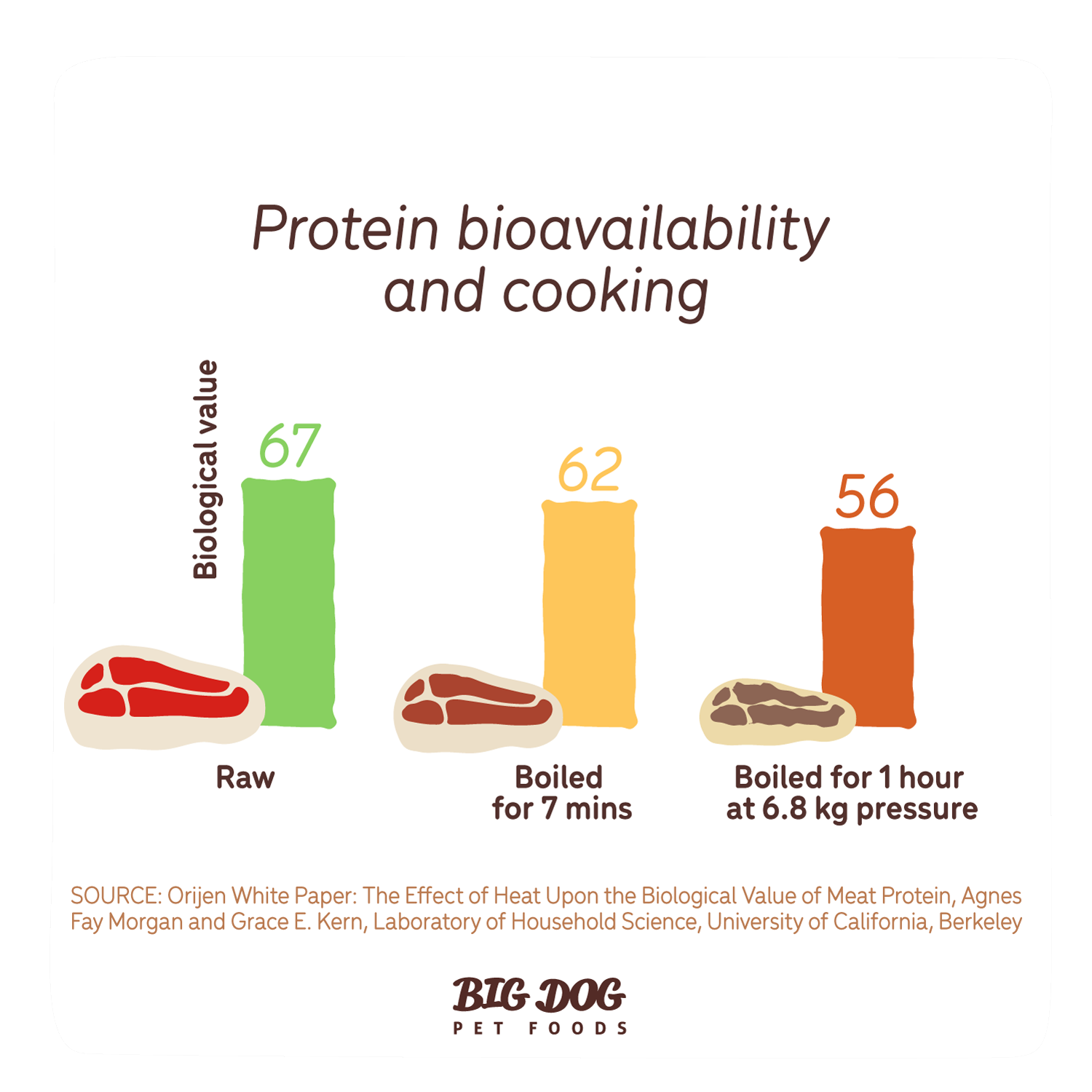
Freezing is another common method of nutrient preservation and is one of the best for natural food preservation. It has a minimal effect on the food and the degradation of nutrition compared to methods involving heat (5,9,15,18).
The method used to make one of the most highly processed types of pet food, kibble, is not just simply mixing and cooking ingredients. It uses an industrial process called extrusion, which uses high temperatures and pressures. We still know little about how it affects pet food but we do know that it affects the quality as it causes starch gelatinisation, protein denaturation, vitamin loss, inactivation of nutritionally active factors, and likely affects lipid oxidisation (25).
These impacts as a result of processing mean that to pass AAFCO nutrient requirements (and claim to be a complete and balanced pet food), synthetic nutrition must be added back in. However, as we have discussed, some of these nutrients are only half as available as they are in their natural form, whereas others if not strictly applied, may be a risk of toxicity over time if added in too high-levels.
But my vet says the blood tests are normal?
The majority of typical blood tests will not show you how well your pet’s body is running deep down, they will show if there is a disease process that needs to be treated. This is because these blood tests do not show the levels of vitamins and minerals as well as the health of the tissue within the body. Meaning that we can’t tell if the cells are thriving or just barely surviving; we cannot test this in an average clinic setting.
What you need to know is that it is up to you as to what you feed your pet and how well their body functions. Choosing foods with naturally occurring nutrients will give your pet the best support for long-term wellness.
So let’s finish this delusion and make a conclusion
Bioavailability is a tough topic to make a brief article, yes… this is brief for me, as the information available states that further research is always needed. However, focusing on the information that is available to us now and what it is telling us certainly points to the whole being indeed, greater than the sum of its parts.
There is certainly a place for synthetic supplementation to help treat specific conditions, but for day-to-day nutrition, from what I have researched there is no point in replacing natural forms of nutrients with synthetic versions.
My aim for my clients is long term benefits through everyday whole food natural meals along with some supplements that can be synthetic if I cannot find a natural option for what I am trying to prevent or treat. Supplementation, whether synthetic or natural, can also be beneficial for diseased animals as the quantities can be increased in smaller ingestible amounts as many sick animals lose their appetites.
Unless there is a medical reason for supplementation, or processing of a pet food has damaged the natural nutrition within, I always recommend a wholefoods diet. Not only because of the rich varied nutrition it contains beyond what AAFCO advises needs to be in a pet food, but because the risk of toxicity if the food isn't manufactured properly is eliminated.
If you are feeding a food that is supplemented with a synthetic mix of vitamins and minerals, your manufacturer should be able to advise what vitamins and minerals they are using and provide testing results to show that they meet AAFCO minimums but more importantly, don’t exceed maximums on some of those nutrients that could lead to toxicity in the long run.
Any company who claims to meet AAFCO through their use of these vitamins and minerals will have these tests to provide to you, to give you this confidence. If they don’t, I wouldn't feed them.
But why feed them synthetic foods anyway? I also like to consider the long term goal with my feeding choices. Processed pet foods are cost effective and this is generally their primary appeal. I encourage everyone to consider that you may be saving on costs in the short-term but in the end you may very well end up spending far more on vet bills in the long-run.
I would advise you to speak to a nutritional veterinarian or animal nutritionist for general feeding advice as well as prior to adding supplements to any animal's diet.
About the Author - Dr Duncan Houston, Veterinarian and Pet Nutritionist

Duncan is a Veterinarian and pet nutrition expert based in Sydney who works mainly as a mobile vet, but also in emergency and general practice. He has a passion for aquatics and nutrition, working with several natural pet food companies for over half a decade.
Triathlon and cycling were integral parts of Duncan’s life where he competed in several different countries taking home numerous achievements. He has always been active and maintains a healthy and exercise induced lifestyle, which he projects onto the animals he treats.
Duncan hopes he can provide you with up to date research and make it relevant to your pets at home. Better to be healthy now and get things right, such as nutrition early, as prevention is always better than cure.
References
- Anturaniemi, J, Zaldívar-López, S, Moore, R, Kosola, M, Sankari, S, Barrouin-Melo, SM & Hielm-Björkman, A 2020, ‘The effect of a raw vs dry diet on serum biochemical, hematologic, blood iron, B12, and folate levels in Staffordshire Bull Terriers', Veterinary Clinical Pathology, vol. 49, no. 2, pp. 258-269. https://doi.org/10.1111/vcp.12852
- Anturaniemi (o.s. Roine), J, Zaldívar-López, S, Savelkoul, HFJ, Elo, K & Hielm-Bjorkman, A 2020, 'The Effect of Atopic Dermatitis and Diet on the Skin Transcriptome in Staffordshire Bull Terriers', Frontiers in Veterinary Science, vol. 7, 552251. https://doi.org/10.3389/fvets.2020.552251
- Barrouin-Melo, SM, Anturaniemi (o.s. Roine), J, Sankari, S, Griinari, M, Atroshi, F, Ounjaijean, S & Hielm-Bjorkman, AK 2016, 'Evaluating oxidative stress, serological- and haematological status of dogs suffering from osteoarthritis, after supplementing their diet with fish or corn oil', Lipids in Health and Disease, vol. 15, 139. https://doi.org/10.1186/s12944-016-0304-6
- Ben-Amotz, A. et al., 1989. Bioavailability of a Natural Isomer Mixture as Compared with Synthetic all-trans-β-Carotene in Rats and Chicks. The Journal of Nutrition, 119(7), pp.1013–1019.
- Bernhardt, S. & Schlich, E., 2006. Impact of different cooking methods on food quality: Retention of lipophilic vitamins in fresh and frozen vegetables. Journal of Food Engineering, 77(2), pp.327–333.
- Burton, G.W., Traber, M.G., Acuff, R.V., Walters, D.N., Kayden, H., Hughes, L. and Ingold, K.U. (1998). Human plasma and tissue alpha-tocopherol concentrations in response to supplementation with deuterated natural and synthetic vitamin E. The American journal of clinical nutrition, [online] 67(4), pp.669–84. Available at: https://www.ncbi.nlm.nih.gov/pubmed/9537614.
- Carr, A. & Vissers, M., 2013. Synthetic or Food-Derived Vitamin C—Are They Equally Bioavailable? Nutrients, 5(11), pp.4284–4304.
- Carr, A. et al., 2013. A Randomized Steady-State Bioavailability Study of Synthetic versus Natural (Kiwifruit-Derived) Vitamin C. Nutrients, 5(9), pp.3684–3695.
- Deb-Choudhury, S. et al., 2014. Effect of Cooking on Meat Proteins: Mapping Hydrothermal Protein Modification as a Potential Indicator of Bioavailability. Journal of Agricultural and Food Chemistry, 62(32), pp.8187–8196.
- Ensminger A. H., et al. 1993. Food & Nutrition Encyclopedia, 2nd ed. New York: CRC Press
- Fabbri, A.D. & Crosby, G.A., 2016. A review of the impact of preparation and cooking on the nutritional quality of vegetables and legumes. International Journal of Gastronomy and Food Science, 3, pp.2–11.
- Garcia-Sartal, C. et al., 2013. Study of cooking on the bioavailability of As, Co, Cr, Cu, Fe, Ni, Se and Zn from edible seaweed. Microchemical Journal, 108, pp.92–99.
- Heaney, R.P., 2001. Factors Influencing the Measurement of Bioavailability, Taking Calcium as a Model. The Journal of Nutrition, 131(4).
- Levine M., Rumsey S., Wang Y., 1996. Vitamin C. In Present Knowledge in Nutrition, 7th ed. Washington: ILSI Press: 146–159.
- Li, D., Zhu, Z. & Sun, D.W., 2018. Effects of freezing on cell structure of fresh cellular food materials: A review. Trends in Food Science & Technology, 75, pp.46–55.
- Lindschinger, M. et al., 2019. A Randomized Pilot Trial to Evaluate the Bioavailability of Natural versus Synthetic Vitamin B Complexes in Healthy Humans and Their Effects on Homocysteine, Oxidative Stress, and Antioxidant Levels. Oxidative Medicine and Cellular Longevity, 2019, pp.1–14.
- Lindschinger M, et al. 2020. Bioverfügbarkeit eines natürlichen versus eines synthetischen Vitamin-B- Komplexes und deren Auswirkungen auf metabolische Prozesse [Bioavailability of natural versus synthetic B vitamins and their effects on metabolic processes]. MMW Fortschr Med. 2020 Mar;162(Suppl 4):17-27. German. doi: 10.1007/s15006-020-0230-4. Epub 2020 Mar 19. PMID: 32189314.
- Liu, R.H., 2003. Health benefits of fruit and vegetables are from additive and synergistic combinations of phytochemicals. The American Journal of Clinical Nutrition, 78(3).
- Mack, A. 1998. All vitamin supplements are not created equal. Med Trib, May 21: 17.
- Melse-Boonstra, A., 2020. Bioavailability of Micronutrients From Nutrient-Dense Whole Foods: Zooming in on Dairy, Vegetables, and Fruits. Frontiers in Nutrition, 7.
- Nelson, E.W., Lane, H. and Cerda, J.J. (1976). Comparative Human Intestinal Bioavailability of Vitamin B-6 from a Synthetic and a Natural Source. The Journal of Nutrition, 106(10), pp.1433–1437.
- Rein, M.J. et al., 2013. Bioavailability of bioactive food compounds: a challenging journey to bioefficacy. British Journal of Clinical Pharmacology, 75(3), pp.588–602.
- 23. Sharma, K. et al., 2020. Bioavailability of Nutrients and Safety Measurements. Functional Foods and Nutraceuticals, pp.543–593.
- Thiel, R.J. (2000). Natural vitamins may be superior to synthetic ones. Medical Hypotheses, 55(6), pp.461–469.
- Tran, Q.D., Hendriks, W.H. and van der Poel, A.F. (2008). Effects of extrusion processing on nutrients in dry pet food. Journal of the Science of Food and Agriculture, 88(9), pp.1487–1493.
- Verghese, M. et al., 2021. Effect of Food Processing on Antioxidant Potential, Availability, and Bioavailability. Annual Review Food Science Technology, (12), pp.307–329.
- Vinson, J.A., Bose, P., 1987. Bioavailability of synthetic ascorbic acid and a citrus extract. Ann New York Academy of Sciences, Vol 498. 525: 526, July 1987.
- Vinson, J.A., Bose, P., 1989. Lemoine L., Hsiao K. H. Bioavailability studies. In Nutrient Availability: Chemical and Biological Aspects. Cambridge (UK): Royal Society of Chemistry: 125–127.
- Vinson, J.A. Human supplementation with different forms of vitamin C. University of Scranton, Scranton (PA).
- Vinson, J.A., Bose, P., 1988. Comparative bioavailability of humans to ascorbic acid alone or in a citrus extract. Am J Clin Nutr; 48: 601–406.
- Vinson, J.A., Hu, S., Jung S.A., 1998. citrus extract plus ascorbic acid decreases lipids, lipid peroxides, lipoprotein oxidative susceptibility, and atherosclerosis in hypercholesterolemic hamsters. J Agric Food Chem; 46: 1453–1469.
- Watzke, H.J., 1998. Impact of processing on bioavailability examples of minerals in foods. Trends in Food Science & Technology, 9(8-9), pp.320–327.
- Weisburger, J.H. 1995. Vitamin C and disease prevention. J Am Coll Nutr; 14(2): 109–111.
